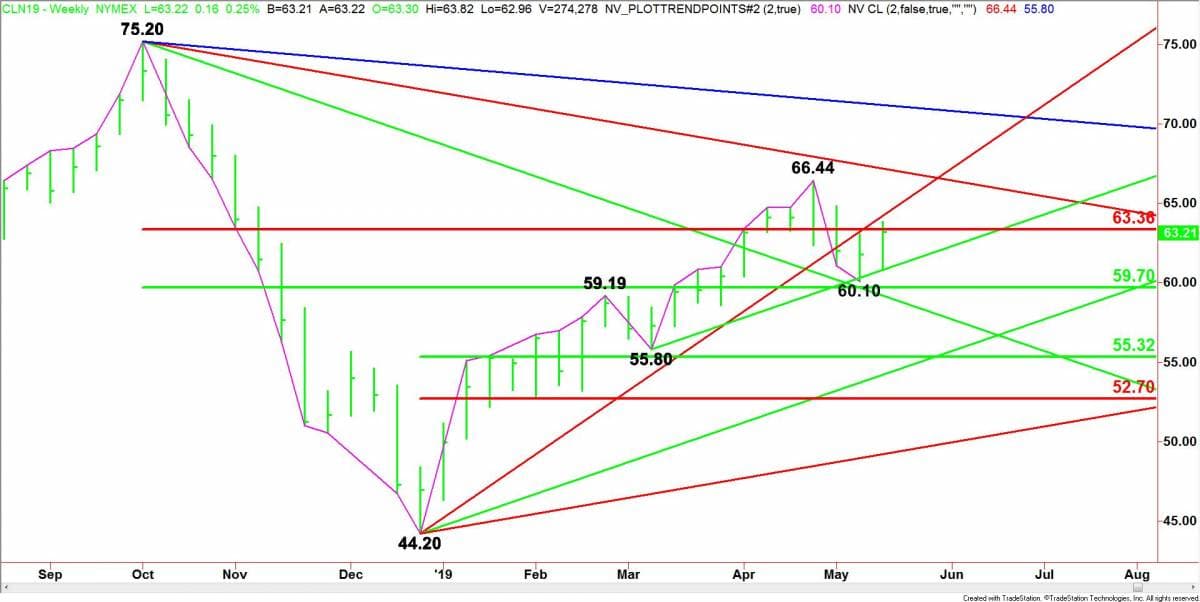U.S. West Texas Intermediate and international benchmark Brent crude oil futures are on track for their first weekly gains this month, while moving into a position to challenge their highs for the year. Fears of supply disruptions, fueled by rising tensions in the Middle East, are the catalysts behind the strong gains.
The bullish theme this week is being driven by worries about supply. Early in the week, prices rose after attacks on Saudi Arabian operations, but those gains were wiped out by renewed concerns over U.S.-China trade relations. However, as the week wore on, crude oil traders put less emphasis on this issue and shifted their focus on potential supply disruptions due to heightened concerns over possible military activity in the Middle East.
Throughout the week, buyers slowly clawed back earlier losses as the headlines continued to indicate tensions were brewing between Iran, the United States and Saudi Arabia. A few isolated incidences drove the price action during the week, but collectively, they pointed toward a potential military conflict in the region. These events include:
Escalation of Middle East Military Activity
According to CNBC, “A Saudi-led military coalition in Yemen carried out several air strikes on the Houthi-held capital Sanaa on Thursday after the Iranian-aligned movement claimed responsibility for drone attacks on two Saudi oil pumping stations earlier in the week.”
U.S. Middle East Activity This Week
Citing…
U.S. West Texas Intermediate and international benchmark Brent crude oil futures are on track for their first weekly gains this month, while moving into a position to challenge their highs for the year. Fears of supply disruptions, fueled by rising tensions in the Middle East, are the catalysts behind the strong gains.
The bullish theme this week is being driven by worries about supply. Early in the week, prices rose after attacks on Saudi Arabian operations, but those gains were wiped out by renewed concerns over U.S.-China trade relations. However, as the week wore on, crude oil traders put less emphasis on this issue and shifted their focus on potential supply disruptions due to heightened concerns over possible military activity in the Middle East.
Throughout the week, buyers slowly clawed back earlier losses as the headlines continued to indicate tensions were brewing between Iran, the United States and Saudi Arabia. A few isolated incidences drove the price action during the week, but collectively, they pointed toward a potential military conflict in the region. These events include:
Escalation of Middle East Military Activity
According to CNBC, “A Saudi-led military coalition in Yemen carried out several air strikes on the Houthi-held capital Sanaa on Thursday after the Iranian-aligned movement claimed responsibility for drone attacks on two Saudi oil pumping stations earlier in the week.”
U.S. Middle East Activity This Week
Citing “very real” threats coming from Iran, U.S. President Trump ordered the deployment of an aircraft carrier group, B-52 bombers and Patriot missiles to the Middle East. Staff were also evacuated from the U.S. embassy in Baghdad.
Trump also told his top advisors he does not want to get the United States involved in a war with Iran, three U.S. officials said on Thursday.
This week’s price action shows that the focus for traders is clearly on the possibility of a supply disruption as investors largely shrugged off another report showing rising U.S. inventories.
U.S. Energy Information Administration Weekly Inventories Report
On Wednesday, the EIA reported that U.S. crude stocks rose unexpectedly the week ending May 10 to their highest since September 2017. Crude stocks swelled by 5.4 million barrels, surprising analysts who had expected a decrease of 800,000 barrels. Gasoline stockpiles, however, decreased more than forecast, according to the EIA.
Traders also shrugged off the potential for lower demand as reported by the International Energy Agency.
IEA Cuts Oil Demand
Also on Wednesday, the International Energy Agency in its latest report, cut oil demand growth estimates for both 2018 and 2019. Last year’s oil demand growth estimate has been revised downward by 70,000 barrels per day (bpd) to 1.2 million bpd, while the forecast for this year was cut by 90,000 bpd to 1.3 million bpd, the IEA said.
Weekly Fundamental Forecast
With tensions running high in the Middle East, look for the bullish tone to carry over into next week. According to reports, the U.S. and Iran aren’t even talking to each other, which could mean both sides are digging in. This could lead to a prolonged stand-off that will only add to the many supply risks.
Secretary of State Mike Pompeo also said last Sunday that all options, military and otherwise, were on the table in case Iran “makes a bad decision.”
Weekly Technical Analysis
Weekly July WTI Crude Oil

The main trend is up according to the weekly swing chart. However, momentum has been trending lower since the week ending April 26 due to the formation of a potentially bearish weekly closing price reversal top. Furthermore, the trend is down on the daily chart. The minor trend is down. This is contributing to the downside momentum.
A trade through $66.44 will signal a resumption of the uptrend. A move through $55.80 will change the main trend to down.
A move through $60.10 will reaffirm the minor downtrend. This will also indicate increased selling pressure.
The main range is $75.20 to $44.20. Its retracement zone at $59.70 to $63.36 is controlling the longer-term direction of the market. The lower or 50% level at $59.70 held as support during the current sell-off. This is an indication that buyers are defending the uptrend. The subsequent rally has led to a retest of the upper or Fibonacci level of this zone at $63.36.
Weekly Technical Forecast
Based on this week’s price action, the direction of the July WTI crude oil market is likely to be determined by trader reaction to the Fibonacci level at $63.36.
Bullish Scenario
A sustained move over $63.36 will indicate the presence of buyers. If this move creates enough upside momentum then look for buyers to make a run at an uptrending Gann angle at $64.20. Overcoming this angle will indicate the buying is getting stronger. This will put crude oil in a bullish position with the next major target the main top at $66.44.
Taking out $66.44 will signal the resumption of the uptrend. This could lead to a test of the downtrending Gann angle at 67.20. This is a potential trigger point for an acceleration to the upside.
Bearish Scenario
A sustained move under $63.36 will signal the presence of sellers. If this move creates enough downside momentum then look for a retest of the uptrending support angle at $61.30.
If $61.30 fails the look for the selling to extend into the minor bottom at $60.10, followed by the major 50% level at $59.70. The market could collapse if the selling pressure is strong enough to take out $59.70 with conviction.
Weekly July Brent Crude Oil

The main trend is also up. A trade through $74.73 will signal a resumption of the uptrend. A trade through $68.76 will change the minor trend to down and shift momentum to the downside.
Brent crude oil is much stronger than its WTI counterpart.
Its main range is $83.71 to $51.78. The market is currently trading on the bullish side of its retracement zone at $71.51 to $67.75.
Look for the bullish tone to continue as long at $67.75 holds as support. Falling below this price will turn the market neutral. Breaking through $67.75 will shift sentiment to the downside.



















